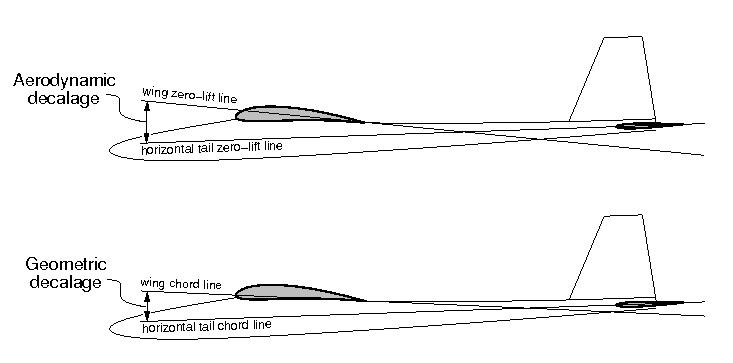Decalage on:
[Wikipedia]
[Google]
[Amazon]
 Decalage on a
Decalage on a
survey of representative biplanes
real-life design decalage is typically zero, with both wings having equal incidence. A notable exception is the Stearman PT-17, which has 4° of incidence in the lower wing, and 3° in the upper wing. Considered from an aerodynamic perspective, it is desirable to have the forward-most wing stall first, which will induce a pitch-down moment, aiding in stall recovery.Appendix C1 to "General Aviation Aircraft Design" by Snorri Gudmundson; section C1.2, p.9
/ref> Biplane designers may use incidence to control stalling behavior, but may also use airfoil selection or other means to accomplish correct behavior. Decalage angle can also refer to the difference in angle of the chord line of the wing and the chord line of the horizontal stabilizer. This is different from the
National Advisory Committee for Aeronautics test reports accessed through the Cranfield University ''AERADE'' website.
Aerospace engineering
 Decalage on a
Decalage on a fixed-wing aircraft
A fixed-wing aircraft is a heavier-than-air flying machine, such as an airplane, which is capable of flight using wings that generate lift caused by the aircraft's forward airspeed and the shape of the wings. Fixed-wing aircraft are distinc ...
is the angle difference between the upper and lower wings of a biplane
A biplane is a fixed-wing aircraft with two main wings stacked one above the other. The first powered, controlled aeroplane to fly, the Wright Flyer, used a biplane wing arrangement, as did many aircraft in the early years of aviation. While ...
, i.e. the acute angle contained between the chords of the wings in question.
Decalage is said to be positive when the upper wing has a higher angle of incidence
Angle of incidence is a measure of deviation of something from "straight on" and may refer to:
* Angle of incidence (aerodynamics), angle between a wing chord and the longitudinal axis, as distinct from angle of attack
In fluid dynamics, ang ...
than the lower wing, and negative when the lower wing's incidence is greater than that of the upper wing. Positive decalage results in greater lift from the upper wing than the lower wing, the difference increasing with the amount of decalage.
In survey of representative biplanes
real-life design decalage is typically zero, with both wings having equal incidence. A notable exception is the Stearman PT-17, which has 4° of incidence in the lower wing, and 3° in the upper wing. Considered from an aerodynamic perspective, it is desirable to have the forward-most wing stall first, which will induce a pitch-down moment, aiding in stall recovery.
/ref> Biplane designers may use incidence to control stalling behavior, but may also use airfoil selection or other means to accomplish correct behavior. Decalage angle can also refer to the difference in angle of the chord line of the wing and the chord line of the horizontal stabilizer. This is different from the
angle of incidence
Angle of incidence is a measure of deviation of something from "straight on" and may refer to:
* Angle of incidence (aerodynamics), angle between a wing chord and the longitudinal axis, as distinct from angle of attack
In fluid dynamics, ang ...
, which refers to the angle of the wing chord to the longitudinal axis of the fuselage, without reference to the horizontal stabilizer.
References
{{reflistExternal links
National Advisory Committee for Aeronautics test reports accessed through the Cranfield University ''AERADE'' website.
Aerospace engineering